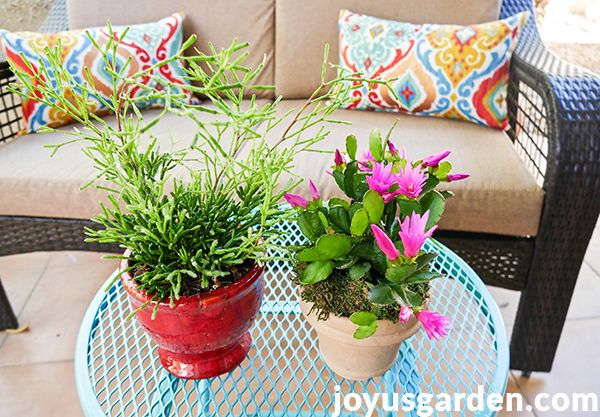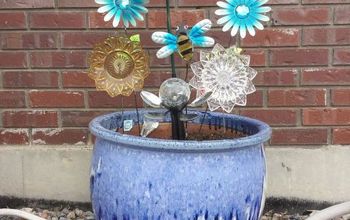What You Need To Know About Growing An Easter Cactus

The cheery Easter Cactus, or Spring Cactus as it’s commonly known these days, is sold in bloom throughout March and April. That bloom can extend well into May depending on the conditions your plant is growing in. But wait, don’t give your cactus the old heave-ho after it’s done blooming. This beautiful succulent makes a splendid houseplant. These tips for growing an Easter Cactus (Spring Cactus) will help keep yours looking good and going strong.
Care & Growing Tips For Easter Cactus (Spring Cactus):
Size
Easter Cacti are most commonly sold in 4, 6 & 8″ pots. They grow to be 1′ x 1′. This is a long-lasting houseplant so older ones (10+ years) can reach 2′ x 2′.
Light
They do best in bright natural light with no direct sunlight. Hot sun will burn the fleshy leaves of a Spring Cactus. Just to give you an idea, mine grows on a buffet in my dining room with 3 large, east facing windows. It sits about 10′ away from those windows where it gets plenty of light (Tucson is known for an abundance of sunshine!).
Growing outdoors, they like bright shade. If you watch the video, the exposure on my covered side patio with a northern exposure is ideal.
Water
These are epiphytic cacti & differ from the desert cacti that I’m surrounded by here in Tucson. In their natural rainforest habitats, they grow on other plants & rocks; not in soil. Their roots need to breathe.
Give yours a good drink of water & let it all thoroughly drain out of the pot. Make sure the plant goes dry before you water it again. You don’t want to keep the roots constantly moist or they’ll eventually rot out.
Let the soil dry out in between waterings. How often you water it depends on quite a few factors. This houseplant watering guide should help you out.
When your Easter Cactus is in bloom, water it more often. You don’t want it to go completely dry at this time.
Temperature
They’re tolerant of a wide range of temperatures. If your house is comfortable for you, it’ll be so for your Easter Cactus too. Just know that the warmer your house is, the quicker the blooming period will be. Keep them away from any heaters, & conversely, any cold drafts.
In order to set blooms, the evening temperature needs to be cool. Between 45 & 55 degrees F is best.
In temperate climates, they can grow outdoors all year long.
Humidity
This epiphytic cactus prefers humidity but does fine in our homes which tend to be on the drier side.
If mine starts to look not as “plump” & a bit on the dry side, I’ll put it on a saucer filled with pebbles & water. Be sure to keep the bottom of the pot out of the water because you don’t want any rotting.
Soil
Spring Cacti grow on other plants, rocks & bark in their natural environments. They don’t grow in soil. In nature, they feed off leaf matter & debris. This means they like a very porous mix that also has some richness to it.
I use mostly succulent & cactus mix (a very chunky local mix) along with compost & coco coir mixed in. This environmentally friendly alternative to peat moss is pH neutral, increases nutrient holding capacity & improves aeration.
Fertilizing
I’ve never fertilized any of my spring Cactus. I always amend with worm compost & organic compost every spring. They’ve always flowered fine. Here in the desert where it’s much hotter & drier, I’ll amend mine again in summer.
Yours may not need it but if you like to fertilize, you can use a balanced liquid houseplant fertilizer (such as 10-10-10) in spring, early summer & mid-summer.
My friend used an all-around orchid fertilizer (20-10-20) on his Christmas Cactus & Easter Cactus once in spring & then again in summer & they looked great. You would want to dilute it to 1/4 strength. Use a 1/4 of the recommended amount of the fertilizer to the water. I have quite a few orchids so I may try using that in summer if need be.
Wait until 1-2 months after your Spring Cactus has completely finished its bloom to fertilize. You want it to rest before hitting it with the good stuff!
Pruning
The only reason I’ve ever pruned mine is to shape or to propagate.
Propagating
Speaking of propagating, it’s very easy to do by either division or leaf cuttings.
You can take individual leaf cuttings by pruning the terminal leaf sections off. I prefer to twist them off which is easy to do. I take a few sections which to me constitutes a stem. I then heal off the leaves or entire stems for a week or so. I plant them in straight succulent & cactus mix (with about 1/2 of the end of the leaf sticking in) & they start to root in a couple of weeks. After a month has gone by, I repot them.
Take the whole leaves – don’t cut the leaf section in half & propagate.
I find propagation is best done 2 or 3 months after flowering is complete.
Pests / Problems
Mine have never gotten any by they are subject to mealybugs, spider mites & maybe scale.
Root rot, a fungal disease, can be a problem too. You can avoid this by not overwatering &/or using a soil mix which is well aerated & free draining.
Flowering
Oh yes, the flowers are a big draw on this plant. There are more star-shaped than the Christmas & Thanksgiving Cacti which to me vaguely resemble a Shrimp Plant flower. You can find them in vibrant violet, peach, red, orange & that more peaceful Easter color white.
The growers time these plants to bloom around Easter. They’re mainly sold in March & April but can bloom well into or throughout May. The warmer your house is, the faster the flowers will open & the shorter the overall period of bloom will be.
Getting them to flower again is just like what you do for to get the Thanksgiving & Christmas Cacti to bloom again. 6-8 weeks before you want your Spring Cactus to bloom make sure it gets equal amounts of light & total darkness each day.
Keep them drier at this time; this helps force them into dormancy. Water them anywhere from every 3-6 weeks depending on the temps, the mix it’s in & the size & type of pot it’s planted in.
You want to keep the temps between 50 & 65 degrees F. 50-55 degrees is best at night. If your temps are warmer, they’ll require a longer period of darkness.
Enjoyed the project?
Resources for this project:
































Frequently asked questions
Have a question about this project?